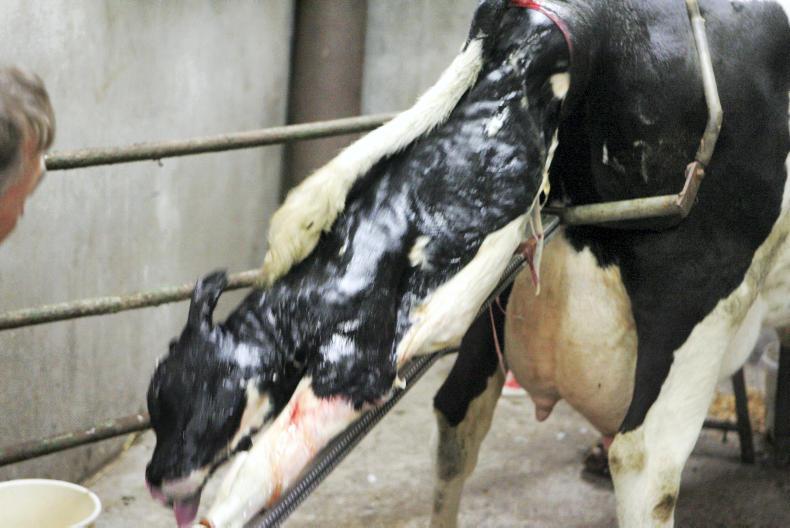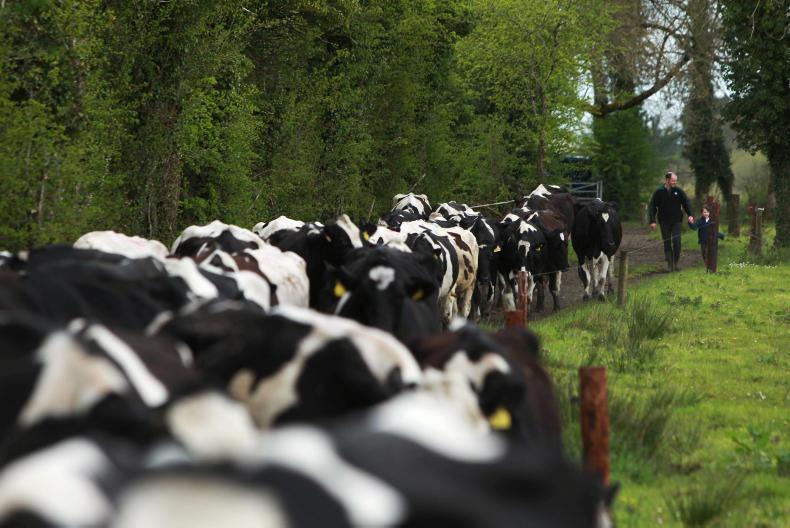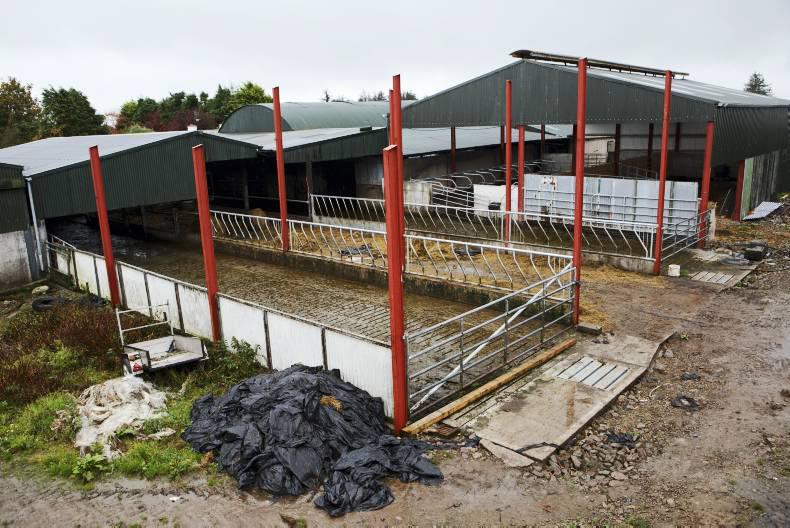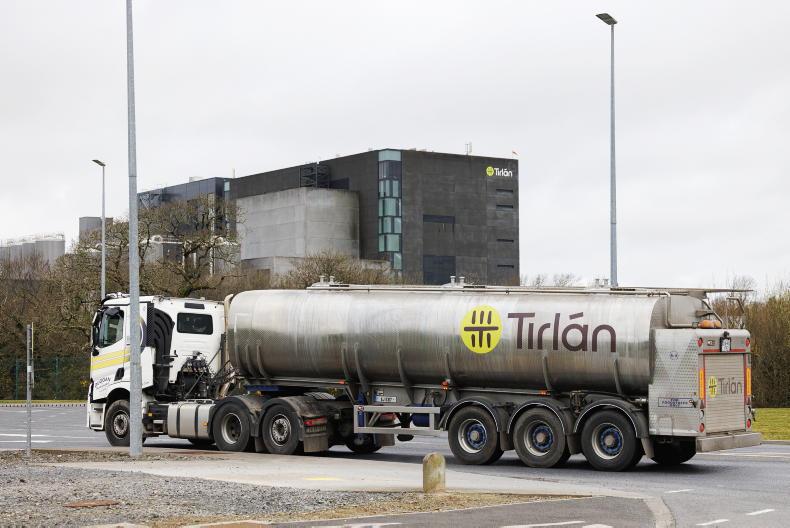Joe Patton, winter milk specialist with Teagasc, summed up the four key measures that need to be addressed on all farms producing winter milk with the four words – start, split, spread and slippage.
He said: “Spring-calving herds start calving late January/early February, but mid-September should be start date for those farmers with a high winter milk contract.
"Whether you calve all in one period or split your herd calving pattern very much depends on your contract for winter milk.”
Joe made it very clear that those farmers calving cows in spring and autumn are working longer hours.
He said: “While I hear some farmers talk about a few cows calving in autumn and a few cows in spring due to the fact that it helps workflow and hours worked, the reality is research has shown that split-calving systems require an extra four hours’ labour per cow per year.
"For a 100-cow herd that’s an extra 400 hours that needs to be found.”
Contracts
Joe explained that it is up to each farm to sort out what they need to calve in autumn and much depends on what your contract for milk over the winter months is.
He said: “If you take a farm with a 50% contract with the optimal two compact calving blocks then it should be early February and early October for start of calving and finish calving in eight to 10 weeks with nothing in the autumn after mid-April in spring and mid-December in winter.
"If you need more milk in winter (70% contract) then you might have to calve slightly earlier (10 September) and maybe 55% of the herd.
“With a lower contract (25% and less) then for a 100-cow herd you only need 15 cows calving in the autumn."
At that stage you have to ask yourself is it worthwhile to be calving at all in autumn – is there a critical mass required? What’s the best decision for your business?
Spread
So that was the bones of Joe’s argument on start date and whether split calving is necessary or not.
Joe then addressed the spread debate. He said you need at least 75% calving down in the first six weeks in spring. Half of those need to be in the first three weeks and late summer calvers need to be removed.
On the slippage point, he said the aim is to keep calving interval for the herd less than 385 days.
Joe said: “The objective is to reduce the cows recycled to less than 10%. At the moment, the average figure for cows moving from one calving period to the next (ie missing autumn breeding but bred the following spring) is 23%.
"If the aim is to cull empty cows then that’s what should happen and it’s a very important part of management.”
Joe talked about a system that would summarise the situation for many Irish winter milk producers. He said if you are producing about 6,000 litres at a high stocking rate then once you pass May calving you start to see very significant increases in the annual feed costs per cow.
Comparing a May-calving cow with a February- or September-calving cow, research has shown you will have 30% higher annual feed costs for the May-calving cow.
Joe said: “That is a very significant figure and it’s extra meal and silage that needs to be fed, so unless there is some other reason, you don’t want to drift into later spring-calving systems as they can be costly.”
Compacting
On the question of late spring calvers filling contracted milk, Joe is clear you would be better off compacting your spring and maybe calving in October if your liquid contract is big enough.
He said: “Autumn-calving cows don’t peak as high but will sustain a flatter curve. So while June calvers could potentially fill contracted winter milk months you need more of them to fill that contract so annualised feed costs are up.
"So the message is compact your spring rather than calve in May and June, and, instead aim for September/October calvers to fill winter milk more cheaply with lower annualised feed costs.”
Joe Patton, winter milk specialist with Teagasc, summed up the four key measures that need to be addressed on all farms producing winter milk with the four words – start, split, spread and slippage.
He said: “Spring-calving herds start calving late January/early February, but mid-September should be start date for those farmers with a high winter milk contract.
"Whether you calve all in one period or split your herd calving pattern very much depends on your contract for winter milk.”
Joe made it very clear that those farmers calving cows in spring and autumn are working longer hours.
He said: “While I hear some farmers talk about a few cows calving in autumn and a few cows in spring due to the fact that it helps workflow and hours worked, the reality is research has shown that split-calving systems require an extra four hours’ labour per cow per year.
"For a 100-cow herd that’s an extra 400 hours that needs to be found.”
Contracts
Joe explained that it is up to each farm to sort out what they need to calve in autumn and much depends on what your contract for milk over the winter months is.
He said: “If you take a farm with a 50% contract with the optimal two compact calving blocks then it should be early February and early October for start of calving and finish calving in eight to 10 weeks with nothing in the autumn after mid-April in spring and mid-December in winter.
"If you need more milk in winter (70% contract) then you might have to calve slightly earlier (10 September) and maybe 55% of the herd.
“With a lower contract (25% and less) then for a 100-cow herd you only need 15 cows calving in the autumn."
At that stage you have to ask yourself is it worthwhile to be calving at all in autumn – is there a critical mass required? What’s the best decision for your business?
Spread
So that was the bones of Joe’s argument on start date and whether split calving is necessary or not.
Joe then addressed the spread debate. He said you need at least 75% calving down in the first six weeks in spring. Half of those need to be in the first three weeks and late summer calvers need to be removed.
On the slippage point, he said the aim is to keep calving interval for the herd less than 385 days.
Joe said: “The objective is to reduce the cows recycled to less than 10%. At the moment, the average figure for cows moving from one calving period to the next (ie missing autumn breeding but bred the following spring) is 23%.
"If the aim is to cull empty cows then that’s what should happen and it’s a very important part of management.”
Joe talked about a system that would summarise the situation for many Irish winter milk producers. He said if you are producing about 6,000 litres at a high stocking rate then once you pass May calving you start to see very significant increases in the annual feed costs per cow.
Comparing a May-calving cow with a February- or September-calving cow, research has shown you will have 30% higher annual feed costs for the May-calving cow.
Joe said: “That is a very significant figure and it’s extra meal and silage that needs to be fed, so unless there is some other reason, you don’t want to drift into later spring-calving systems as they can be costly.”
Compacting
On the question of late spring calvers filling contracted milk, Joe is clear you would be better off compacting your spring and maybe calving in October if your liquid contract is big enough.
He said: “Autumn-calving cows don’t peak as high but will sustain a flatter curve. So while June calvers could potentially fill contracted winter milk months you need more of them to fill that contract so annualised feed costs are up.
"So the message is compact your spring rather than calve in May and June, and, instead aim for September/October calvers to fill winter milk more cheaply with lower annualised feed costs.”
Winter milk yields: “Yield levels are average and milk solids are low but are improving.”Two-year-old calving: “The percentage of this winter milk herd calving as two-year-old heifers is 35% to 40% for liquid milk herds; that’s where we are as a sector but need to improve.”Calving pattern for country: “We had 200,000 extra cows for 2016 and of those 95% calving in January to April so the message to drive lower cost systems is working.” 









SHARING OPTIONS